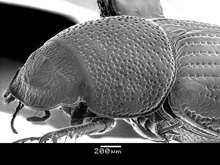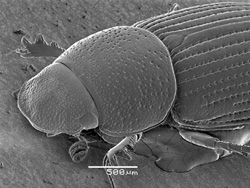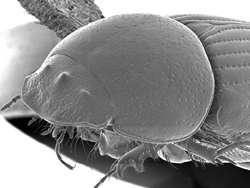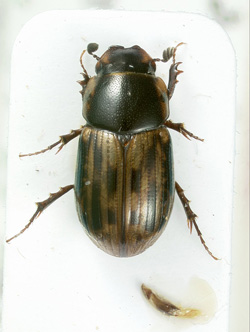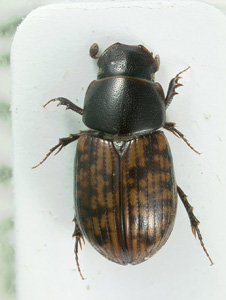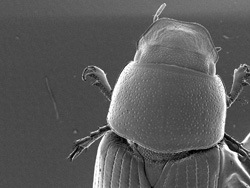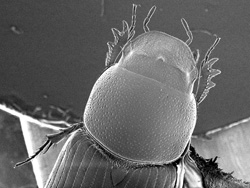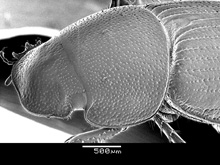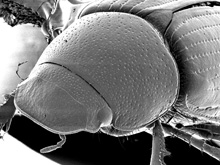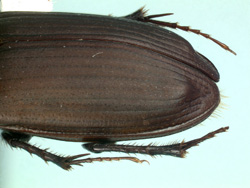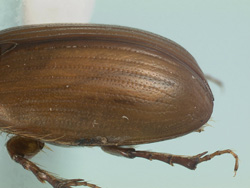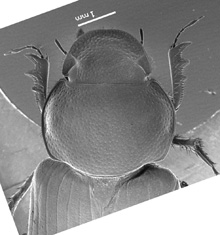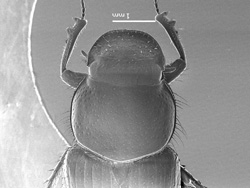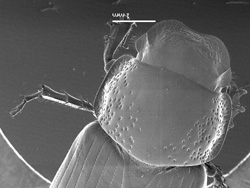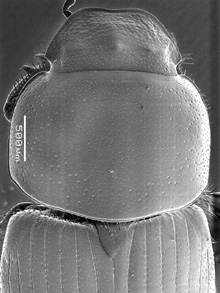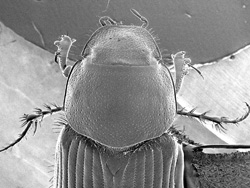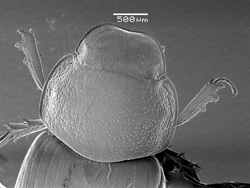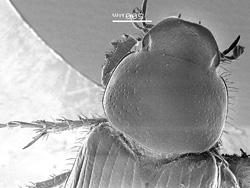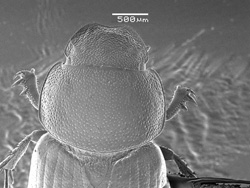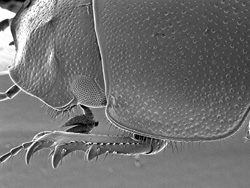|
|
| |
61(60).
.
.
|
Body length 4 mm or less. Each elytron yellow with 2 large black marks and a dark sutural margin (Fig. 92). Southwestern North America |
Pardalosus
Gordon and Skelley (in part) |
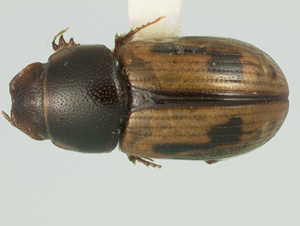 Figure 92. Pardalosus pumilio.
Figure 92. Pardalosus pumilio. |
61'.
.
.
|
Body length variable, usually more than 4 mm. Elytron black or red, frequently with numerous small black marks or large pale spots |
|
|
| |
|
| |
62(61).
.
.
.
.
.
|
Body black, entire elytron and anterior pronotal angles red. Head surface shiny, frontal suture with distinct median tubercle, usually trituberculate (Fig. 93). Male pronotum with distinct median apical depression. Body robust, length 6 mm or more. North America and Mexico |
.
.
.
.
.
Aphodius Illiger |
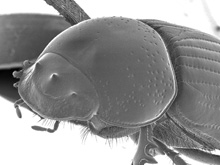 Figure 92. Aphodius fimetarius.
Figure 92. Aphodius fimetarius.
|
62'.
.
.
.
.
.
|
Body and elytra usually same color; if notably contrasting, then elytron with distinct markings. Head surface variable, frontal suture often lacking median tubercle. Pronotum lacking depression at median apical margin. Body robust or not, usually somewhat flattened, length variable |
|
|
| |
|
| |
63(62).
.
.
|
Body entirely red, robust, not at all flattened (Fig. 94). Lateral pronotal margin straight from angle to angle in lateral view (Fig. 95). Nebraska and Texas |
Oscarinus
Gordon and Skelley (in part) |
| |
63'.
.
.
.
|
Body mostly black, not entirely red, robust or not (often weakly flattened). Lateral pronotal margin curved in lateral view, most notably near anterior or posterior angles (Fig. 96) |
|
|
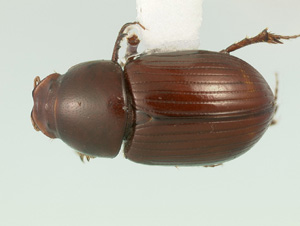 |
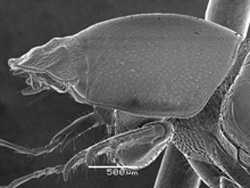 |
Figure 94. Oscarinus mataganae. |
Figure 94. Oscarinus mataganae. |
|
Figure 94. Planolinoides neotomae. |
|
| |
|
| |
64(63).
.
.
.
.
|
Clypeal surface with transverse ridge (Fig. 97) (indistinct in P. borealis). Elytron lacking color pattern. Body length less than 5 mm. Male parameres distinctly shortened, nearly as long as wide. Western and northern North America |
.
.
Planolinoides Dellacasa and Dellacasa |
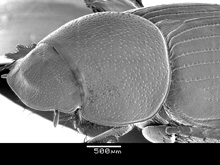 Figure 97. Planolinoides pectoralis.
Figure 97. Planolinoides pectoralis. |
64'.
.
.
.
|
Clypeus without transverse ridge (if transverse ridge present, body entirely red). Elytron with or without color pattern. Body length variable. Male parameres distinctly longer than wide. Widespread |
|
|
| |
|
| |
65(64).
.
.
|
Body robust; color dark brown, elytral intervals usually paler on declivity. Elytral striae with coarse punctures, intervals strongly convex |
.
.
66 |
| |
65'.
.
.
|
Body usually not robust, elongate, if robust then color uniformly black. Elytral striae with moderate punctures, not strongly convex; widespread |
|
|
| |
|
| |
66(65).
.
.
|
Lateral elytral intervals distinctly punctate (Fig. 98). Head lacking distinct tubercle in both sexes. Mexico
. |
‘Agrilinus’ (s.l.) Mulsant and Rey (in part) |
| |
66'.
.
.
.
|
Lateral elytral intervals finely punctate (Fig. 99). Head with distinct median tubercle in male, weak tubercle in female. Caribbean and Central America to southern Texas |
|
|
|
|
Figure 98. Agrilinus ornatus. |
Figure 99. Haroldiellus sallei, male |
|
| |
|
| |
67(65).
.
.
.
|
Pronotum dark, elytra variously spotted with yellowish marks (Fig. 100-101). Head lacking median tubercle. Male paramere distinctly half length of basal piece. Mexico |
‘Agrilinus’ (s.l.) Mulsant
and Rey
(in part) |
| |
67'.
.
.
.
.
|
Color variable, elytra entirely dark, usually not spotted with yellowish marks, often with large color patches or spotted in black. Head frequently with median tubercle. Male paramere nearly equal length of basal piece. Mexico and North America |
|
|
|
|
Figure 100. Agrilinus azteca. |
Figure 101. Agrilinus azteca, female |
|
| |
|
| |
68(67).
.
|
Clypeus broadly rounded on each side (Fig. 102). Frontal suture lacking median tubercle |
.
69 |
| |
68'.
.
|
Clypeus rounded or not (Fig. 103). Frontal suture usually with median tubercle |
|
|
|
|
Figure 102. Planolinus tenellus. |
Figure 103. Planolinellus vittatus, male |
|
| |
|
| |
69(68).
.
.
|
Elytral intervals with distinct punctures (Fig. 104), most notable laterally. Northern and western North America |
.
Liothorax Motschulsky |
| |
69'.
.
|
Elytral intervals lacking distinct punctures (Fig. 105). More widespread, boreal |
|
|
|
|
Figure 104. Liothoraxn alternatus. |
Figure 105. Planolinus tenellus. |
|
| |
|
| |
70(69).
.
|
Metafemur normal, distinctly longer than wide
. |
Planolinus Mulsant and Rey |
| |
70'.
.
|
Metafemur nearly quadrate, nearly as wide as long (Fig. 106) |
|
|
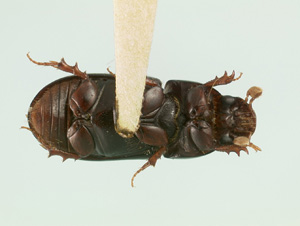 Figure 106. Merogyrus rotindiceps.
Figure 106. Merogyrus rotindiceps. |
| |
|
| |
71(68).
.
.
.
|
Length less than 5 mm. Clypeal surface dull and finely punctate (Fig. 107). Elytron black with variable sized red marks at humerus and apex, often nearly entirely red. Widespread |
.
Planolinellus Dellacasa and Dellacasa |
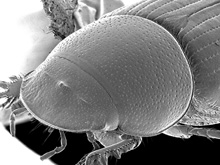 Figure 107. Planolinellus vittatus, male.
Figure 107. Planolinellus vittatus, male. |
71'.
.
.
.
|
Length variable, usually larger than 5 mm. Clypeal surface and punctation variable, shiny. Elytral color variable on larger specimens, smaller specimens entirely dark brown to black |
|
|
| |
|
| |
72(47).
.
|
Elytra with distinct apical umbone (Fig. 108). Andean region of South America |
.
73 |
| |
72'.
.
|
Elytra lacking distinct apical umbone (Fig. 109). Mexico and North America |
|
|
|
|
Figure 108. Pseudopodotenus fulviventris. |
Figure 109. Orodaliscoides reflexus. |
|
| |
|
| |
73(72).
.
|
Apical pair of protibial teeth broadly joined (Fig. 110). Body pale brown. Chile |
Symphodon Schmidt |
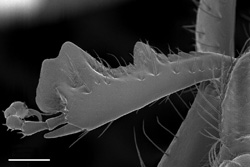 Figure 110. Symphodon anomalum.
Figure 110. Symphodon anomalum.
|
73'.
.
.
|
Apical pair of protibial teeth normal, widely separated. Body usually black, elytra occasionally pale. Andean region of South America |
|
|
| |
|
| |
74(73).
.
|
Alternating elytral intevals moderately convex with weak pubescent tubercles. Chile |
Podotenus
Schmidt |
| |
74'.
.
.
|
Alternating elytral intervals not alternately modified, or lacking pubescent tubercles. Andean region of South America |
|
|
| |
|
| |
75(74).
.
.
.
|
Abdomen orange, contrasting against black body. Pronotal hind angles distinct, base strongly sinuate (Fig. 111). Male protibia distinctly bidentate, female distinctly tridentate. Chile, Argentina |
.
.
Pseudopodotenus G. Dellacasa |
| |
75'.
.
.
.
|
Abdomen and body dark, not contrasting. Pronotal hind angle rounded, base weakly sinuate (Fig. 112). Male and female protibia weakly tridentate. Chile, Argentina, Ecuador, Bolivia |
.
.
|
|
|
|
Figure 111. Pseudopodotenus fulviventris, female. |
Figure 112. Paranimbus peruanus, male. |
|
| |
|
| |
76(72).
.
.
.
.
|
Pronotal base usually lacking marginal line at middle (Fig. 113), if fine line present (Fig. 114), then coarse pronotal punctures lacking on most of disc. Pronotum broad and explanate, often reflexed with lateral shelf, usually with depression near posterior angles |
.
.
.
.
77 |
| |
76'.
.
.
.
|
Pronotal base with distinct marginal line (Fig. 115). Pronotum usually not broad or explanate; if pronotum explanate, then punctures of disc evenly distributed over surface |
|
|
|
|
Figure 114. Cryptoscatomaseter brevicollis. |
Figure 115. Chilothorax distinctus, male. |
|
| |
|
| |
77(76).
.
.
.
|
Clypeus, lateral pronotal margin and elytron with sparse lateral fringe of long setae (Fig. 116). Pronotal disc never with depression near posterior lateral angle. Mexico and southwestern North America |
Cephalocyclus
Dellacasa, Gordon
and Dellacasa
(in part) |
| |
77'.
.
.
.
|
Lateral margin of elytron, pronotum, and clypeus lacking fringe of setae (Fig. 117). Pronotal disc often with depression near posterior lateral angle. Mexico to Canada |
|
|
|
|
Figure 116. Cephalocyculs luteolus. |
Figure 117. Cryptoscatomaseter ejectus. |
|
| |
|
| |
78(76).
.
|
Pronotum with lateral fringe of long setae easily visible in dorsal view (Fig. 118) |
.
79 |
| |
78'.
.
.
.
|
Pronotum lacking lateral fringe of long setae, setae not visible in dorsal view (Fig. 119), or setal fringe short and dense (Fig. 120), appearing more uniform in length |
|
|
|
|
Figure 118. Flaviellus aggregatus. |
Figure 119. Geomyphilus geronimo. |
|
Figure 120. Agoliinus ashworthi. |
|
| |
|
| |
79(78).
.
|
Body and elytra dark brown to black, elytra occasionally with paler markings |
Phaeaphodius Reitter (in part) |
| |
79'.
.
|
Body and elytra pale, occasionally with black pronotal disc and elytral markings |
|
|
| |
|
| |
80(79).
.
.
|
Pronotum black; elytron with distinct color pattern of black spots on yellow background (Fig. 121). North America |
Chilothorax Motschulsky (in part) |
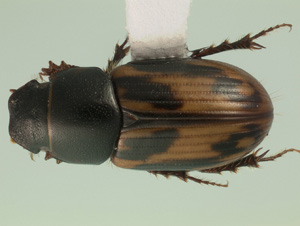 Figure 121. Chilothorax distinctus.
Figure 121. Chilothorax distinctus. |
80'.
.
|
Pronotum usually not black, if black, then elytron lacking color pattern |
|
|






